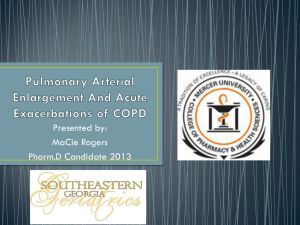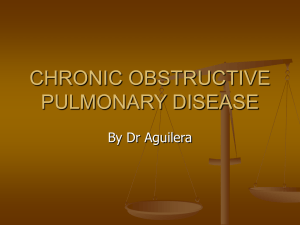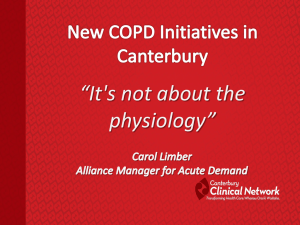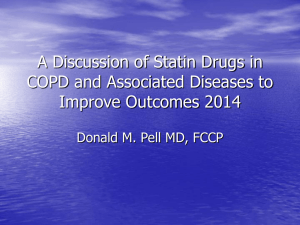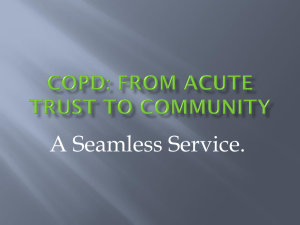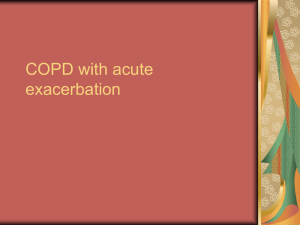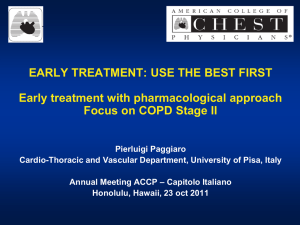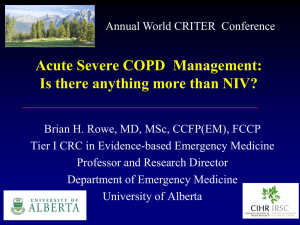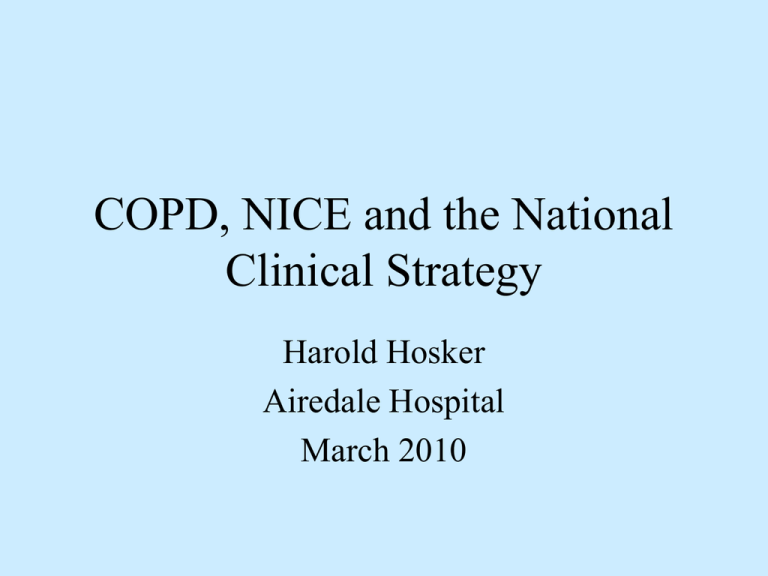
COPD, NICE and the National
Clinical Strategy
Harold Hosker
Airedale Hospital
March 2010
Inflammation
• COPD is a disease state characterised by airflow
limitation that is not fully reversible. The airflow
limitation is usually both progressive and
associated with an abnormal inflammatory
response of the lungs to noxious particles or gases
• Chronic inflammation is caused by increased
numbers of activated inflammatory cells,
specifically neutrophils, which can damage lung
structure and lead to mucosal oedema and airway
narrowing
The impact of COPD
• More than 30,000 deaths annually in the UK
• UK – 900,000 diagnosed patients
• Allowing for underdiagnosis, the true number of
patients with COPD in England and Wales is
likely to be around 1.5 million
• Currently the fifth greatest cause of mortality
worldwide – over 2.5 million deaths in 2000
• By 2020, COPD will be the third leading
cause of mortality
• Exacerbations have an impact on patient
quality of life and can be life-threatening
The typical COPD patient
– Generally over 40 years
– A smoker or ex-smoker
– Presentation with:
» cough
» excessive sputum
production
» shortness of breath /
wheeze
COPD is a heterogeneous disease
• Spectrum of clinical disease from ‘pink
puffer’ to ‘blue bloater’
• Several different pathological processes
Inflammatory mechanisms in COPD
Cigarette smoke
?
CD8+
lymphocyte
Alveolar macrophage
Neutrophil chemotatic factors,
cytokines (IL-8)
mediators (LTB4)
Neutrophil
Protease
inhibitors
1-antitrypsin
-
Neutrophil elastase
Proteases
Alveolar wall destruction
(emphysema)
mucus hypersecretion
(chronic bronchitis)
What is Spirometry?
Spirometry is a method of
assessing lung function by
measuring the volume of air the
patient can expel from the lungs
after a maximal expiration.
Why Perform Spirometry?
• Measure airflow obstruction to help make a definitive
diagnosis of COPD
• Confirm presence of airway obstruction
• Assess severity of airflow obstruction in COPD
• Detect airflow obstruction in smokers who may have few
or no symptoms
• Monitor disease progression in COPD
• Assess one aspect of response to therapy
• Assess prognosis (FEV1) in COPD
• Perform pre-operative assessment
Spirometry – Additional Uses
• Make a diagnosis and assess severity in a range of
other respiratory conditions (eg ILD, MND, G-B)
• Distinguish between obstruction and restriction as
causes of breathlessness
• Screen workforces in occupational environments
• Assess fitness to dive
• Perform pre-employment screening in certain
professions
Types of Spirometers
• Bellows spirometers:
Measure volume; mainly in lung
function units
• Electronic desk top spirometers:
Measure flow and volume with real time
display
• Small hand-held spirometers:
Inexpensive and quick to use but no
print out
Volume Measuring Spirometer
Flow Measuring Spirometer
Small Hand-held Spirometers
Lung Volume Terminology
Inspiratory reserve
volume
Total
lung
capacity
Inspiratory
capacity
Tidal volume
Expiratory reserve
volume
Residual volume
Vital
capacity
Standard Spirometric Indices
• FEV1 - Forced expiratory volume in one second:
The volume of air expired in the first second of the blow
• FVC - Forced vital capacity:
The total volume of air that can be forcibly exhaled in one breath
• FEV1/FVC ratio:
The fraction of air exhaled in the first second relative to the total
volume exhaled
• VC - Vital capacity:
A volume of a full breath exhaled in the patient’s own time and not
forced. Often slightly greater than the FVC, particularly in COPD
Normal Trace Showing FEV1 and FVC
FVC
Volume, liters
5
4
FEV1 = 4L
3
FVC = 5L
2
FEV1/FVC = 0.8
1
1
2
3
4
5
Time, seconds
6
Spirogram Patterns
• Normal
• Obstructive
• Restrictive
• Mixed Obstructive and Restrictive
Predicted Normal Values
Affected by:
Age
Height
Sex
Ethnic Origin
Criteria for Normal
Post-bronchodilator Spirometry
• FEV1: % predicted > 80%
• FVC: % predicted > 80%
• FEV1/FVC: > 0.7
Spirometry: Obstructive Disease
Volume, liters
5
4
Normal
3
FEV1 = 1.8L
2
FVC = 3.2L
1
FEV1/FVC = 0.56
1
2
3
4
5
Time, seconds
6
Obstructive
Diseases Associated With
Airflow Obstruction
•
•
•
•
•
•
•
COPD
Asthma
Bronchiectasis
Cystic Fibrosis
Sarcoidosis
Lung cancer (greater risk in COPD)
Obliterative Bronchiolitis
Spirometry: Restrictive Disease
Normal
Volume, liters
5
4
3
Restrictive
2
FEV1 = 1.9L
FVC = 2.0L
1
FEV1/FVC = 0.95
1
2
3
4
5
Time, seconds
6
Diseases Associated with a Restrictive
Defect
Pulmonary
• Fibrosing lung diseases
• Pneumoconioses
• Pulmonary edema
• Parenchymal lung tumors
• Lobectomy or
pneumonectomy
Extrapulmonary
• Thoracic cage deformity
• Obesity
• Pregnancy
• Neuromuscular disorders
• Fibrothorax
Spirometry
• In COPD and asthma,
spirometry is preferred to
peak flow (PEFR)
readings
• Serial PEFR readings can
confirm / exclude
variability (asthma)
• Chest X-ray excludes
other pathologies but does
not usually diagnose
COPD
Flow Volume Curve
• Standard on most desk-top spirometers
• Adds more information than volume
time curve
• Less understood but not too difficult to
interpret
• Better at demonstrating mild airflow
obstruction
Flow Volume Curve
Maximum
expiratory flow
(PEF)
Expiratory
flow rate
L/sec
TLC
FVC
Inspiratory
flow rate
L/sec
Volume (L)
RV
COPD - dynamic hyperinflation
COPD - exertional dyspnoea
Flow volume loop - severe COPD
Flow (l/s)
12
Predicted
Baseline
Post BD
10
8
6
4
2
2
-2
-4
-6
-8
4
6
8
Volume (litres)
Flow volume loop - asthma
Flow (l/s)
12
Predicted
Baseline
Post BD
10
8
6
4
2
2
-2
-4
-6
-8
4
6
8
Volume (litres)
Flow volume loop - restrictive (fibrosis)
Flow (l/s)
12
Predicted
Baseline
Post BD
10
8
6
4
2
2
-2
-4
-6
-8
4
6
8
Volume (litres)
Flow volume loop - large airways obstruction
(stridor)
Flow (l/s)
12
Predicted
Baseline
Post BD
10
8
6
4
2
2
-2
-4
-6
-8
4
6
8
Volume (litres)
Bronchodilator Reversibility Testing
• Provides the best achievable FEV1
(and FVC)
• Helps to differentiate COPD from asthma
Must be interpreted with clinical history neither asthma nor COPD are diagnosed
on spirometry alone
Bronchodilator Reversibility Testing
in COPD
Results
•An increase in FEV1 that is both greater
than 200 ml and 12% above the prebronchodilator FEV1 (baseline value) is
considered significant
•It is usually helpful to report the absolute
change (in ml) as well as the % change
from baseline to set the improvement in a
clinical context
Equipment Maintenance
• Most spirometers need regular calibration to
check accuracy
• Calibration is normally performed with a 3 litre
syringe
• Some electronic spirometers do not require
daily/weekly calibration
• Good equipment cleanliness and anti-infection
control are important; check instruction manual
• Spirometers should be regularly serviced; check
manufacturer’s recommendations
Other lung function tests
• Lung volumes
– Helium dilution, body box (plethysmography)
– TLC (RV derived)
• Gas transfer
– Single breath carbon monoxide transfer
– TLCO and KCO (=TLCO/Va)
• Mouth pressures
– Indirect measure of muscle / diaphragm strength
– Pimax, PEmax
Emphysema - the ‘pink puffer’
Damage to alveoli in emphysema
Effect of cigarette smoke on
airspaces in mice (scanning EM)
A: smoke-exposed mice B: matched controls (6 months)
Pathological processes in
emphysema
• Loss of alveolar surface area
• Loss of lung elasticity
• Hyperinflation causing mechanical
inefficiency
• Muscle weakness / cachexia
• Small airways collapse
• Dynamic hyperinflation
Alveolar wall damage leading to
small airways collapse in COPD
Chronic bronchitis: the ‘blue bloater’
Pathological processes in
chronic bronchitis
•
•
•
•
•
•
•
•
Bronchoconstriction
Airway mucosal inflammation / oedema
Airway remodelling / fibrosis
Mucus hypersecretion
Epithelial / ciliary dysfunction
Ventilation - perfusion mismatch
Hypoxic pulmonary vasoconstriction
Cor pumonale
The role of exacerbations in disease progression
•
Following an exacerbation, the likelihood of
further exacerbation increases
•
Exacerbations are closely associated with
cumulative reduction in health status
•
High frequency of COPD exacerbations is
associated with a rapid decline in lung function
and increased risk of hospitalisation
•
Up to 70% of patients admitted to hospital with an
exacerbation are re-admitted within a year
COPD Guidelines
• The British Thoracic Society (BTS) guidelines
for the management of COPD 1997
• Global Strategy for the Diagnosis,
Management and Prevention of COPD
(GOLD), last update in 2001 and are constantly
under peer review (www.goldcopd.com)
• NICE guidelines were published in 2004, due
for revision 2010
1. COPD Guidelines Group of the Standards of Care Committee of the BTS. 1997.
2. Pauwels RA et al. 2001.
NICE/BTS Recommendations
• Diagnose COPD
• Stop Smoking
• Effective inhaled therapy
• Pulmonary Rehabilitation
• NIV
• Manage exacerbations
• Multi-disciplinary working
Inhaled steroids in COPD
– No evidence of benefit in mild / moderate
COPD
– Do not affect the rate of decline in FEV1
– Beneficial effect on quality of life and
exacerbation rate in moderate / severe disease
– Dose response and long term safety in COPD
are not known1
Drug therapy in COPD
• Combination therapy
– Inhaled steroid plus long-acting B2 agonist
– Several studies show additive benefit using fluticasone /
salmeterol or budesonide / eformoterol
– Benefits include FEV1 change, exacerbation rates,
symptom scores and health status improvements
– New combinations (including triple combinations and
ultra-long acting beta agonists) are on their way
– Roflumilast (PDE-4 inhibitor) due 2010
TORCH: study design
3-year study duration (6,112 patients)1
(sub-cut population 4,511 patients2)
Full study Sub-cut data
SeretideTM 500 Accuhaler™
Fluticasone propionate 500 mcg
2 week
run-in
Salmeterol 50 mcg
Control group
1 Year
1.
2.
Vestbo et al. Eur Respir J 2004
GSK Data on File SERTCODOF012
2 Years
n=1,533
n=1,117
n=1,534
n=1,126
n=1,521
n=1,142
n=1,524
n=1,126
3 Years
All-cause mortality at 3 years
Probability of death (%)
18
16
14
12
10
8
6
4
Placebo
SALM
FP
SALM/FP
2
0
0
12 24 36 48 60 72 84 96 108 120 132 144 156
Time to death (weeks)
Number 1524
alive
1533
1521
1534
1464
1487
1481
1487
1399
1426
1417
1409
Vertical bars are standard errors
1293
1339
1316
1288
Premature study drug discontinuation
Probability of withdrawal (%)
HR 0.69, p< 0.001
48
44
40
36
32
28
24
20
16
12
8
SFC
Control
4
0
0
12
24
36
48
60
72
84
96
108
120
132
144
156
Time to withdrawal from study medication (weeks)
SFC = salmeterol/fluticasone
propionate combination
Calverley et al. NEJM 2007
Rate of moderate and severe exacerbations
over three years
Mean number of exacerbations/year
1.2
1.13
25% reduction
0.97*
1
0.93*
0.85*†‡
0.8
0.6
0.4
0.2
0
Placebo
SALM
FP
SALM/FP
Treatment
*p < 0.001 vs placebo;
†p
= 0.002 vs SALM;
‡p
= 0.024 vs FP
Calverley et al. NEJM 2007
UPLIFT trial
NEJM October 2008
• A 4 year trial of tiotropium in COPD involving 5993
patients
• Real life study – all patients allowed to continue all
other Rx except inhaled anti-cholinergics
• 46% patients were GOLD stage II (FEV1 50% – 80%
predicted) ie mild disease
• 44% GOLD stage III, 8% GOLD stage IV
• 60% patients on LABAs, 62% on ICS, with more than
70% on each by end of trial
UPLIFT: rate of decline in lung function
Kaplan-Meier Estimates of the Probability of COPD Exacerbation and Death from Any Cause
UPLIFT trial exacerbations
• 14% reduced risk of exacerbations (time to
1st exacerbation)(p<0.001) and
exacerbations leading to hospitalisations
(p=0.002)
• But no difference in hospital days
• Seretide and Tiotropium both reduce
exacerbations to a similar extent (INSPIRE
study)
UPLIFT – safety of Tiotropium
• UPLIFT shows no increased risk of cardiac
death with Tiotropium (significantly
reduced risk – 27% risk reduction in CVS
death, also stroke)
• 16% risk reduction in probability of death,
p=0.034)
• No evidence of increased CVS risk from
LABAs either
Case study – Margaret
Margaret is 52 years old.
She works in an office and
has two children
She has smoked around 25
cigarettes a day for 30 years
Her FEV1 is 65% predicted
Margaret’s father died 4
years ago of ‘chest disease’
She has a productive cough
and finds she is breathless
on exertion both at work
and at leisure
Last winter she had a bad
chest infection
She has tried various
inhalers
The stages of COPD – NICE
Mild
(FEV1
50–80%)
Moderate
(FEV1
30–49%)
Breathlessness and
exercise limitation
Short- and long-acting bronchodilators
2-agonists/anticholinergics
If still symptomatic consider a
trial of combination long-acting
2-agonist and inhaled
corticosteroid*
Consider adding theophylline
Severe
(FEV1
<30%)
Prevention of
exacerbations
If still symptomatic despite
maximum inhaled
bronchodilator consider
referral for specialist
assessment
1. NICE Guideline No.12. Thorax 2004. *Discontinue if no benefit after 4 weeks
In patients suffering two or
more exacerbations per year
add inhaled corticosteroid
usually in combination with
long-acting bronchodilators
Case study – Margaret (age 52)
Diagnosis
Margaret has mild/moderate COPD
History
Has tried to quit smoking
Chest infection last winter
Prescribed various inhalers
FEV1 = 65% predicted normal
Symptoms
Breathlessness on exertion getting worse
Productive cough
What do Margaret’s symptoms stop her doing?
Enjoying leisure activities with her family
Playing bowls
Managing Margaret’s COPD
Smoking
Breathlessness and
exercise limitation
Exacerbations
QoL
Managing Margaret’s COPD
Smoking
Breathlessness and
exercise limitation
Exacerbations
QoL
Managing Margaret’s COPD
symptoms
Smoking
Breathlessness and
exercise limitation
Exacerbations
QoL
Further minimising the impact of
exacerbations
• The impact of exacerbations should be minimised by:
– Giving self-management advice on responding promptly to the
symptoms of an exacerbation
Starting appropriate treatment with oral corticosteroids and/or
antibiotics
– Use of non-invasive ventilation when indicated
– Use of hospital-at-home or assisted-discharge schemes
Managing Margaret’s COPD
Smoking
Breathlessness and
exercise limitation
Exacerbations
QoL
Managing Margaret’s COPD
• Encourage and help her to stop
smoking
• Check that Margaret's inhaled therapy
is in line with her disease severity and
that both symptoms and frequency of
exacerbations are taken into
consideration. This may involve
treatment with LAMAs, and / or
LABAs
• Check Margaret is able to use and
understands the benefit of the
treatments she is prescribed
• Consider other interventions, e.g.
pulmonary rehabilitation
• Work with Margaret to develop a selfmanagement plan
FEV1 (% of value at age 25)
Stopping smoking
slows decline in lung function
Never smoked or not
susceptible to smoke
100
75
Smoked regularly
and susceptible to
its effects
50
Stopped at 45
Disability
25
Stopped at 65
Death
0
25
50
Age (years)
Adapted from: Fletcher et al, Br Med J 1977.
75
Pulmonary rehabilitation
• Pulmonary rehabilitation is a multidisciplinary programme of care for
patients with COPD and is individually tailored to optimise a patient’s
physical and social performance1
• Identify patients who will benefit from pulmonary rehabilitation, usually
MRC dyspnoea scale grade 3 or above1
Grade
Degree of breathlessness related to activity
1
Not troubled by breathlessness except on strenuous exercise
2
Short of breath when hurrying or walking up a slight hill
3
Walks slower than contemporaries on level ground because of breathlessness
or has to stop for breath when walking at own pace
4
Stops for breath after walking about 100m or after a few minutes on level
ground
5
Too breathless to leave the house or breathless when dressing or undressing
1. NICE guideline No. 12. Thorax 2004.
Recognising an exacerbation
• Give written information on recognising
worsening symptoms, such as:
– You get much more breathless than you did
before (doing the same thing)
– You produce more sputum than before
– Your sputum becomes discoloured
– You feel feverish or unwell
– Cough gets worse
1. NICE guideline No. 12. Thorax 2004.
NICE – inhaler technique
• In most cases bronchodilator therapy is best administered
using a hand-held inhaler device (including a spacer device
or other aid if appropriate)
• If the patient is unable to use a particular device
satisfactorily or it is not suitable for him/her, an alternative
should be found
• Inhalers should be prescribed only after patients have
received training in the use of the device and have
demonstrated satisfactory technique
1. NICE guideline No. 12. Thorax 2004.
Case 2 - George
•
•
•
•
•
•
•
•
•
75 year old ex-steel worker
Ex-smoker, 45 pack years
Chronic productive cough
Gradually progressive SOB and wheeze over ten years
Regular antibiotics for bronchitis most winters
Limited exercise capacity
Difficulty shopping, playing with grandkids, walking to pub
15 year history of of ‘asthma’ – bricanyl/beclomethasone
No family history of asthma/no pets
Points for discussion
• Diagnosis
• Impact on Patient
• What else do you need to know?
– What do you need to ask?
– Examination?
– What investigations do you need?
How do we exclude asthma?
Spirometry FEV1 = 40%
FEV1 /FVC = 50%
George
•
•
•
•
•
75 year old man
No night-time wakening
No day to day variability in symptoms
No acute precipitants
No diurnal variation in PEFR
Therefore no significant asthmatic element
Presentation sponsored by GlaxoSmithKline LM34524 LOM/SLK/06/28416/1
George
•
•
•
•
•
•
•
•
75 year old man
Moderate COPD
Enjoyed pulmonary rehabilitation
Started combination treatment of ICS and LABA
Also on LAMA (tiotropium)
Less frequent daily symptoms
Less exacerbations requiring antibiotics
Better exercise capacity, mild limitation
Case 3 - Stanley
•
•
•
•
76 yr old man
10yr history of COPD
Ex-smoker, (50 pack years)
Current Rx
–
–
–
–
ICS/LABA combination
Tiotropium
Theophylline
Mucolytic
Stanley
• Housebound
– Unable to walk to pub
•
•
•
•
•
Living in sitting room
Sleeps in chair
Weight loss
Declines social services assistance
DN noted ankle oedema
Points for discussion
• FEV1 = 35%
• FEV1/FVC = 50%
• What else do you need to know?
– What would you ask?
– Examination?
– Investigations?
LTOT Assessment
• Surgery pulse oximetry
– Sats <92%
– Measure when COPD stable
– repeated after 6 weeks
• Or refer for assessment (ABG)
National Clinical Strategy for COPD
• Started in 2005 (as an ‘NSF’) following pressure from
BLF and BTS; originally scheduled for 2007 publication;
then 2008; then launch in spring 2009; then winter 2009;
now April 2010……..
• Currently the final document being shared with ministers
• 12 week consultation from Dec 2009, including workshops
nationally
• Focus on clinical pathways and managed clinical networks
• Now includes asthma and home oxygen services (OSA to
follow later)
Issues behind the national clinical
strategy
• COPD is a ‘Cinderella’ disease with little funding or strong
advocacy
• A lack of awareness of COPD by healthcare professionals
and the public
• Little focus on prevention and risk reduction
• Large numbers of people not diagnosed or inaccurately
classified
• No clear or uniform care pathways and models of care
provision including for acute and chronic care
• Varying access to early discharge schemes, pulmonary
rehabilitation and supportive care
• Access to specialist services at end of life is poor
National Clinical Strategy for COPD
• Launch end of Q1 2010
• New DH Respiratory Programme Board
• Variety of guidance / educational resources
etc
• Need to reduce:
– Variation in care / outcomes
– Unnecessary tests / duplication
– Ineffective prescribing (25% of oxygen
prescriptions are ineffective)
National Clinical Strategy for COPD:
national structure
• National Clinical Leads
• Respiratory Leads in each of 10 SHAs
• Trust Medical Directors (acute Trusts and
PCTs)
– Ensure local leadership
– Promote local respiratory networks
National Clinical Strategy for COPD
• Guidelines on diagnostics and case-finding
spirometry
• Competency framework for HCPs
• COPD commissioning guidance
• Metrics for primary and secondary care
• Tariffs (reduce disincentives)
• DH – develop ‘Lung Improvement Programme’ to
develop managed lung clinical networks, start
national pilots, share information, resources etc
‘Lung Improvement Programme’
Major areas for piloting
• Good Lung Health – smoking, case-finding, health
checks
• Diagnostic Hub – accurate diagnostics for COPD,
sleep, asthma, oxygen assessment
• Care closer to home – personal health plans
• Transforming inpatient care – structured
admission, EDS, integrated care, daily respiratory
team involvement
• End of Life care – care plans, carers, death at
home / hospice (60% die in hospital)
Oxygen services
• Concern re commissioning, implementation
and costs of current national oxygen
services
• Costs £110 M pa
• 25% prescriptions – no benefit
• 300 NPSA alerts / SUI and 44 oxygen
related deaths
• Plan to re-commission in 2011
“Well, I guess I’ve taken up enough of your time…..”

